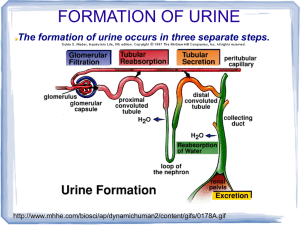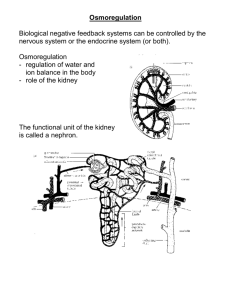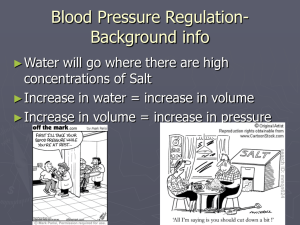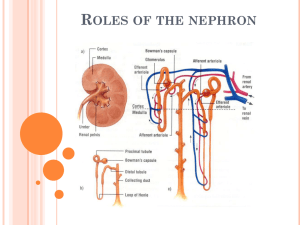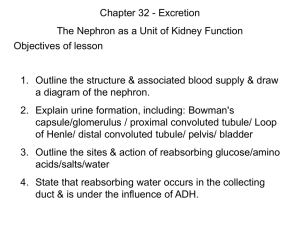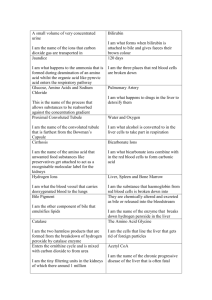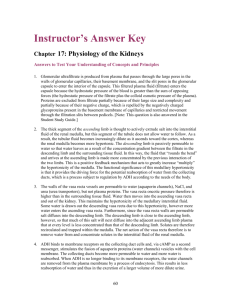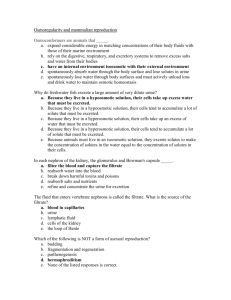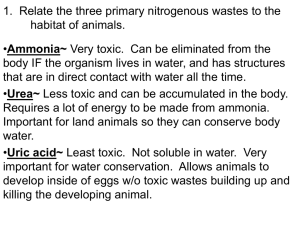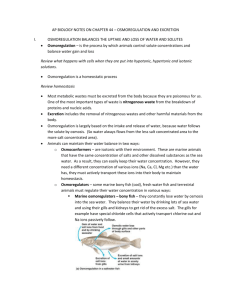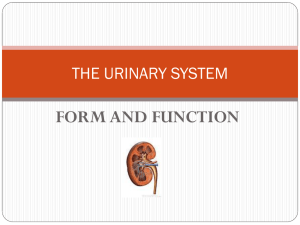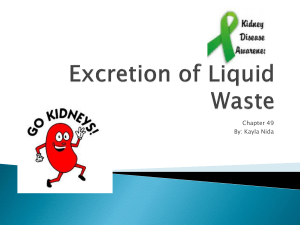Urinary System Label the diagrams of the urinary system and kidney
advertisement
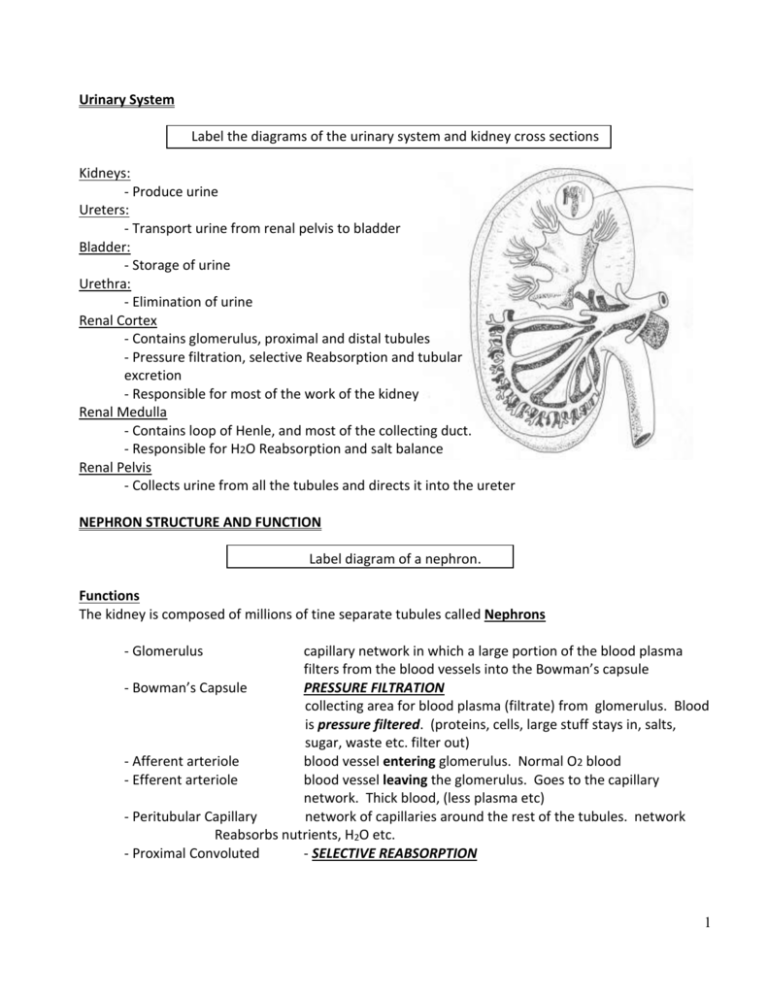
Urinary System Label the diagrams of the urinary system and kidney cross sections Kidneys: - Produce urine Ureters: - Transport urine from renal pelvis to bladder Bladder: - Storage of urine Urethra: - Elimination of urine Renal Cortex - Contains glomerulus, proximal and distal tubules - Pressure filtration, selective Reabsorption and tubular excretion - Responsible for most of the work of the kidney Renal Medulla - Contains loop of Henle, and most of the collecting duct. - Responsible for H2O Reabsorption and salt balance Renal Pelvis - Collects urine from all the tubules and directs it into the ureter NEPHRON STRUCTURE AND FUNCTION Label diagram of a nephron. Functions The kidney is composed of millions of tine separate tubules called Nephrons - Glomerulus capillary network in which a large portion of the blood plasma filters from the blood vessels into the Bowman’s capsule - Bowman’s Capsule PRESSURE FILTRATION collecting area for blood plasma (filtrate) from glomerulus. Blood is pressure filtered. (proteins, cells, large stuff stays in, salts, sugar, waste etc. filter out) - Afferent arteriole blood vessel entering glomerulus. Normal O2 blood - Efferent arteriole blood vessel leaving the glomerulus. Goes to the capillary network. Thick blood, (less plasma etc) - Peritubular Capillary network of capillaries around the rest of the tubules. network Reabsorbs nutrients, H2O etc. - Proximal Convoluted - SELECTIVE REABSORPTION 1 tubule - sugar and salts and amino acids are actively transported out of filtrate (tubule) back into the blood (Capillary network) Uses ATP, O2. Walls are covered with microvilli. - The filtrate is now less concentrated than the blood, so water moves from the filtrate to the blood by diffusion - Loop of Henle - dips down into medulla - more H2O is absorbed into blood from descending limb - Na+ and Cl- also reabsorbed (in the ascending loop) - urea diffuses out of the collecting duct and into the ascending limb. This adds to the hypertonic solution of the medulla and allows the kidney to excrete very hypertonic urine (concentrated) -Distal Convoluted Tubule - TUBULAR EXCRETION - a few materials are actively excreted from blood into tubules. (penicillin, histamines, H+, etc.) - Collecting duct - Common duct which collects filtrate from many distal tubules (Nephron) - Very important in regulating the overall water content of urine - Can control from very dilute urine (lots of water) to very concentrated urine, (very little water, most reabsorbed) Control of Blood pH by the Kidney If blood is too acidic (too much H+ ions) Distal Tubule keeps H+ and NH3- (these ions stay in the filtrate/urine) Distal Tubule releases Na+ and HCO3- (ions move from filtrate into blood) If blood is too basic (too much OH- ions) Just the opposite happens 2 TERMS TO USE Waste (histamines, H+, etc) Efferent arteriole Glomerulus Pressure Filtration Filtrate Peritubular Capillary Network Distal Conv. Tubule Venule Proximal Convoluted Tubule Water Collecting duct Selective Reabsorption Afferent arteriole Tubular excretion Sugar, amino acids Loop of Henle Proteins, Blood cells Bowman’s Capsule Salts BLOOD IN RENAL ARTERY AND VEIN Substance Renal Artery Renal Vein - Glucose - 100 mg/l - 98 mg/l - Urea - 30 mg/l - 25 mg/l Glucose is 100% reabsorbed from the filtrate into the blood. The 2 mg/l drop above is a result of sugar used to make ATP to fuel all the active transport that is happening in the tubules. Urea is lower in the renal vein because it is excreted in the filtrate. Some is reabsorbed by the tubules. The kidneys do not remove all the wastes from the blood, they remove enough to keep the blood at a constant level. 3 One kidney can actually be sufficient, a human can easily survive with only one. Sometimes people will donate a kidney to a close relative. ADH AND ALDOSTERONE i) ADH - Anti Diuretic Hormone - controls H2O balance - ADH is secreted by the posterior pituitary gland - increases the permeability of the distal tubule and collecting duct so that more water can be reabsorbed back into the blood. - if ADH is secreted: blood volume increases blood becomes more dilute urine becomes more concentrated blood pressure increases - ADH secretion is controlled by the water content of the blood. As blood concentration increases, more ADH is secreted, so more water is reabsorbed, and blood concentration then decreases. ii) Aldosterone - hormone secreted by adrenal cortex gland (outer layer of the adrenal gland on top of each of the kidneys). - controls the excretion of Na+ and K+ - increases Reabsorption of Na+ (inc. Na+ in blood) - increases excretion of K+ (decreases K+ in blood) - If blood Na+ level is too low, Aldosterone is secreted, Reabsorption of Na+ by the kidneys occurs, so blood Na+ begins to increase. - also controls blood volume (& pressure). Increase in Na+ in blood causes H20 to be reabsorbed, increasing blood volume & pressure Role of Hypothalamus - area of the brain directly above the pituitary gland The hypothalamus actually secretes the ADH which is released by the Posterior pituitary gland. The hormone is transferred and stored in a series of nerve cells which run from the hypothalamus to the posterior pituitary gland. The actual concentration (water) of the blood is monitored by the hypothalamus. If the blood is too concentrated, the hypothalamus triggers the posterior pituitary gland to release the ADH. The ADH increases the permeability of the distal tubule and collecting duct, so that more water is reabsorbed from the urine back into the blood. As the blood becomes more dilute, less hormone is secreted. If the blood is too dilute, no ADH is released, the kidney tubules stay impermeable, so little water is reabsorbed (dilute urine) and the blood begins to become more concentrated. Summary - blood is too concentrated 4 - Hypothalamus triggers Posterior Pituitary Gland to secrete ADH - more H2O is reabsorbed by collecting duct and distal tubule - blood becomes more dilute - blood is too dilute - Hypothalamus causes less ADH to be secreted - Little H2O is reabsorbed by collecting duct and distal tubule - Blood becomes more concentrated NEPHRON STRUCTURE PARTS A. B. E. F. C. D. G. 5 URINARY SYSTEM Written Questions 1. 2. 3. 4. 5. 6. 7. 8. List four metabolic wastes, and explain how each is formed. (8) List the path of urine through the urinary system. (4) List all the parts of a nephron tubule (do not include the blood vessels). (5) List the pathway of blood around a nephron. (4) Explain the terms; Pressure Filtration, Selective Reabsorption, and Tubular Excretion. (6) Where and how is water removed from the filtrate (think areas of the nephron)? (3) Explain the role of the hypothalamus and ADH in regulating the water content of urine. (2) Explain how the kidney maintains blood pH. (2) 6
